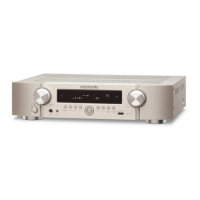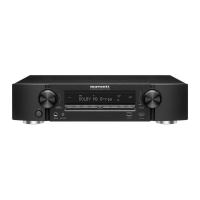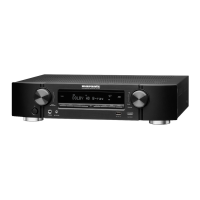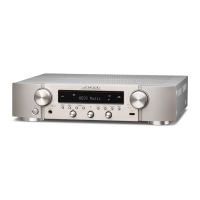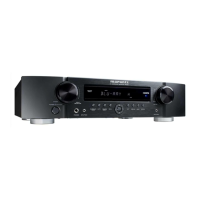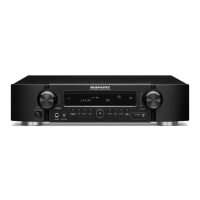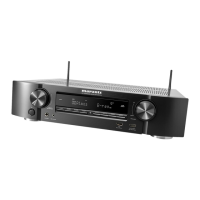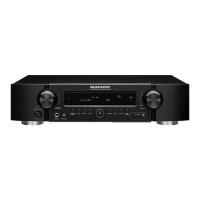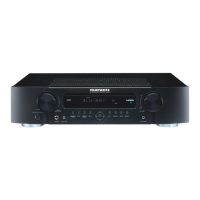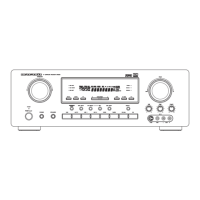What does it mean when Marantz Receiver power indicator is blinking red?
- PpatriciadiazSep 9, 2025
This indicates that the unit’s amplifier circuit has failed. Turn off the power and please contact the Marantz service adviser.






What does it mean when Marantz Receiver power indicator is blinking red?
This indicates that the unit’s amplifier circuit has failed. Turn off the power and please contact the Marantz service adviser.
Why does my Marantz NR1604 Receiver power turn off and the power indicator flashes red every 2 seconds?
If your Marantz Receiver power turns off and the power indicator flashes red approximately every 2 seconds, it means the protection circuit has been activated because the unit is overheating. Turn the power off and wait about an hour for it to cool down. Then, turn it on again. Also, make sure the unit is installed in a place with good ventilation.
Why does my Marantz NR1604 Receiver power automatically switch to standby mode?
The sleep timer might be active; try turning the power on again or adjusting the sleep timer settings. Also, the 'Auto Standby' feature activates after a period of inactivity. To disable this, go to the menu and set 'Auto Standby' to 'Off'.
How to enable DTS sound output on my Marantz NR1604 Receiver?
If DTS sound is not being output by your Marantz Receiver, set “Decode Mode” in the menu to either “Auto” or “DTS.”
What to do if no video is output with HDMI connection on my Marantz Receiver?
If you're not getting any video output via HDMI on your Marantz Receiver, first check all HDMI connections to ensure they are secure. Next, make sure the input source on the receiver is set to match the HDMI connector being used. Finally, verify that your TV is compatible with HDCP copyright protection, as incompatible devices may prevent correct video output.
How to improve reception on my Marantz NR1604 Receiver?
If you're experiencing reception issues, noise, or distortion with your Marantz Receiver, try adjusting the antenna's orientation or position. Separate the AM loop antenna from the unit, consider using an FM outdoor antenna, and ensure the antenna is separated from other connection cables.
What to do if Marantz NR1604 set does not operate properly?
Try resetting the microprocessor. Keep in mind that this will restore all pre-configured settings to the factory defaults.
What to do if Marantz Receiver displays no picture?
Verify the connection between the video output terminal of the unit and the input terminal of the TV. Ensure the input settings match the input terminal of the TV connected to the unit.
Why can't I select Dolby PLg or DTS NEO:6 mode on my Marantz Receiver?
If Dolby PLg mode or DTS NEO:6 mode cannot be selected on your Marantz Receiver, check that “Speaker Config.” – “Center” or “Surround” is set to something other than “None.” This sound mode cannot be selected if the speaker system is 2.0 or 2.1 channel. Also, Dolby PLg or DTS NEO:6 cannot be selected when headphones are in use.
Why is no sound produced from surround back speakers of Marantz NR1604?
Check if 'Assign Mode' is set correctly for audio output from the surround back speakers. Set 'Speaker Config.' – 'Surr. Back' on the menu to something other than 'None'. Also, ensure the sound mode is not set to 'STEREO' or 'VIRTUAL'.
Lists all parts included with the Marantz AV receiver.
Step-by-step instructions for inserting batteries into the remote control unit.
Information on the optimal distance and angle for operating the remote control.
Details the power amplifier's discrete circuit technology for superior sound quality.
Highlights HDMI features, iPod/USB direct play, and multi-room audio capabilities.
Describes the user-friendly Setup Assistant and Graphical User Interface.
Labels and identifies all components and controls on the front panel.
Explains the function of power, headphones, setup, and mode selection buttons.
Details additional front panel controls like volume, input selector, and indicators.
Explains the main information display and input signal indicators.
Describes indicators for ZONE2, MUTE, and Sleep Timer status.
Details indicators related to tuner reception, playback source, and Audyssey features.
Explains indicators for Dolby/DTS decoders and surround back speaker output.
Identifies all terminals and connectors located on the rear panel.
Details connection ports for FM antenna, audio, video, and HDMI devices.
Explains ports for digital audio, network (LAN), and external control devices.
Explains ZONE SELECT, input source selection, and information buttons.
Details system, tuning, and sound mode selection buttons.
Covers the POWER, MUTE, and VOLUME adjustment buttons on the remote.
Explains OPTION, ENTER, cursor navigation, SETUP, and FAVORITE buttons.
Lists different types of devices that can be connected to the unit.
Illustrates common cables used for connecting various audio/video devices.
Provides guidance on optimal speaker placement in a listening environment.
Details speaker setup for Dolby Pro Logic II and multi-channel configurations.
Step-by-step instructions for correctly connecting speaker cables.
Illustrates the procedure for connecting a subwoofer to the unit.
Explains bi-amp connection and using external amplifiers for front speakers.
Outlines connection methods based on TV's HDMI and ARC capabilities.
Details connecting a TV that supports both HDMI and Audio Return Channel (ARC).
Explains connecting a TV with HDMI, using an optical cable for audio.
Describes connecting a TV without HDMI using video or component cables.
Introduces video input/output connectors and connection recommendations.
Illustrates connections for set-top boxes, DVD players, and video camcorders.
Details connecting iPods and USB memory devices to the unit's USB port.
Lists compatible iPod and iPhone models for music playback.
Shows how to connect the supplied FM antenna for optimal reception.
Explains connecting the unit to a home network for various functions.
Details recommended router features and LAN cable types for network connection.
Explains connecting a wireless receiver for Bluetooth audio playback.
Details connecting external IR receivers and Marantz devices for remote control.
Covers controlling devices via Marantz Remote App and using the DC OUT jack.
Shows how to properly connect the power cord to the unit and power outlet.
Covers turning the unit on/off and selecting input sources.
Introduces playback of various media sources like iPod, USB, FM, and Internet Radio.
Covers playback from PC/NAS, Last.fm, Spotify, and Flickr.
Highlights convenience functions, sound modes, HDMI control, and ZONE2 playback.
Explains how to turn the unit on and switch it to standby mode.
Details how to select the desired input source for playback.
Guides on adjusting the master volume and temporarily muting audio.
Outlines the procedure for playing content from DVD or Blu-ray disc players.
Describes connecting an iPod via USB for music playback.
Explains how to configure iPod browse modes for on-screen display.
Guides on setting repeat playback and enabling random playback modes.
Provides a step-by-step guide for playing files stored on USB memory devices.
Lists advanced playback options accessible via the OPTION button.
Explains how to tune into FM stations using TUNE buttons and modes.
Details RDS, PTY, and TP search functions for finding specific stations.
Guides on selecting preset stations and managing them.
Guides on preparing for and selecting Internet Radio sources.
Details using vTuner to add and manage favorite Internet Radio stations.
Explains playing music files and playlists stored on PC/NAS via network.
Guides on configuring media sharing settings in Windows Media Player for PC/NAS access.
Introduces the Last.fm service for music discovery and personalized radio.
Introduces viewing public photographs shared on Flickr.
Introduces the Spotify service and its requirements for playback.
Introduces AirPlay for streaming music from Apple devices over the network.
Guides on managing repeat/random playback and favorites.
Details playing music with pictures (slideshow) and selecting video during audio.
Covers adjusting picture quality and playing music in multiple zones.
Introduces various surround and stereo playback modes supported by the unit.
Explains Direct and Pure Direct playback modes for enhanced sound quality.
Describes Auto surround playback which automatically selects the best mode.
Explains various Dolby audio technologies and sound modes.
Covers various DTS audio technologies and sound modes.
Defines Original (Stereo, Virtual) and AUTO sound modes.
Guides on setting up HDMI control for connected devices and checking functionality.
Explains how to set and cancel the sleep timer for automatic standby.
Guides on accessing and controlling the unit through a web browser interface.
Explains how to back up and restore unit settings for recovery.
Guides on enabling, disabling, and canceling the panel lock function.
Explains how to enable or disable the remote control sensor.
Details connecting ZONE2 speakers via output terminals or an external amplifier.
Guides on selecting ZONE2 mode, power, and input source for playback.
Lists audio-related settings and their corresponding pages.
Lists video-related settings and their corresponding pages.
Lists input and speaker configuration settings and their pages.
Lists network and general configuration settings and their pages.
Explains how to navigate and operate the settings menu on the TV screen.
Details how to input characters using the on-screen keyboard for naming and searching.
Covers adjusting dialog level for center channel clarity and subwoofer output.
Explains Home Theater EQ for softening treble and Loudness Management.
Details LFE adjustment, panorama for wider sound, and dimension for balance.
Covers Center Width for dialogue distribution and Height Gain for volume.
Guides on adjusting bass and treble levels for tonal quality.
Explains M-DAX for enhancing compressed audio and its operational modes.
Covers adjusting audio delay for sync and setting volume scale/limit.
Explains setting power-on volume and mute attenuation level.
Introduces Audyssey setup and guidelines for microphone placement.
Details MultEQ®, Dynamic EQ, and Dynamic Volume calibration features.
Guides on using Graphic EQ for tone adjustment and selecting speakers.
Details EQ band adjustment, copying Audyssey Flat curve, and resetting defaults.
Guides on adjusting picture quality using modes like Movie, Vivid, etc.
Details adjustments for contrast, brightness, saturation, and hue.
Explains noise reduction, sharpness enhancer, and HDMI setup options.
Guides on selecting video processing modes and enabling video conversion.
Details i/p Scaler processing and output resolution settings.
Explains progressive mode conversion and aspect ratio settings.
Guides on setting the position of volume display and operation status.
Guides on selecting the video signal format (PAL/NTSC) for the TV.
Explains assigning HDMI, digital, analog, component, and video connectors to input sources.
Guides on renaming input sources and hiding unused ones.
Details adjusting playback levels for selected input sources.
Guides on setting audio input modes (Auto, HDMI, Digital, Analog).
Explains setting the audio decode mode (Auto, PCM, DTS).
Introduces Audyssey setup and guidelines for microphone placement.
Guides on manually configuring speakers and amplifier assignments.
Details setting speaker presence and size categories for calibration.
Explains settings for surround back and front height speakers.
Guides on setting speaker distances from the listening position.
Details adjusting speaker levels using test tones for balanced output.
Guides on setting crossover frequencies for speakers based on size.
Details selecting subwoofer modes (LFE, LFE+Main) for bass reproduction.
Guides on selecting front speaker usage (A, B, A+B) for sound modes.
Explains displaying network info and enabling IP control for standby operation.
Guides on changing the unit's name displayed on the network.
Guides on configuring network connection via DHCP or manually setting IP address.
Explains setting the subnet mask, default gateway, and DNS addresses.
Details configuring proxy server settings and port number for Internet access.
Guides on checking physical connection, router access, and internet connectivity.
Covers setting the menu language and configuring ZONE2 audio playback.
Details adjusting channel output levels and volume settings.
Explains settings for maximum volume, power-on volume, and mute attenuation.
Guides on renaming zones and configuring trigger out activation.
Explains setting the timer for automatic standby mode based on inactivity.
Guides on selecting front display modes (On, Auto Off, Off).
Shows how to display video signal, HDMI, and zone information.
Covers viewing firmware version and configuring notification alerts.
Explains options for sending anonymous usage data to Marantz.
Guides on checking for, and initiating firmware updates for the unit.
Explains how to display and install new features available for download.
Guides on enabling/disabling Setup Lock to protect settings from changes.
Explains how to specify the zone (MAIN/ZONE2) for remote control operation.
Provides tips on managing volume levels, subwoofer output, and audio clarity.
Offers advice on network, gaming delay, and Wi-Fi connection.
Addresses power issues, remote control operation failures, and display problems.
Troubleshoots no sound output from speakers and DVI-D connections.
Addresses problems with selecting sound formats and Audyssey features.
Troubleshoots video output issues and iPod playback problems.
Addresses issues with USB memory device and network file playback.
Troubleshoots HDMI control function failures and no sound in ZONE2.
Guides on resetting the unit to its factory default settings.
Explains HDMI interface, Deep Color, x.v.Color, 3D, 4K, and Auto Lip Sync.
Provides further details on HDMI control features and ARC functionality.
Lists supported audio formats (PCM, Bitstream) and video signal formats.
Explains HDCP technology for protecting digital content transmission.
Illustrates how input video signals are converted before output to TV.
Shows conversion capabilities from input signals to output resolutions.
Details USB device compatibility, formats, and limits on playable files.
Lists supported audio and image file formats for USB playback.
Lists supported audio file formats and their specifications for PC/NAS playback.
Lists specifications for playable Internet Radio broadcast stations.
Explains the function that saves last selected settings for input sources.
Stores settings made before entering standby mode.
Shows which channels are used for different sound modes and speaker configurations.
Maps sound modes to adjustable surround parameters like Dialog Level, Subwoofer Level.
Maps sound modes to parameters like Tone, Audyssey, M-DAX.
Maps 2-channel and multi-channel input signals to corresponding sound modes.
Defines terms starting with A and B, including Bluetooth and Audyssey features.
Defines DLNA, Dolby Digital, Pro Logic, and DTS audio technologies.
Defines FLAC audio codec, HDCP protection, and iTunes player.
Defines LFE, MAIN ZONE, Modem, MP3, and MPEG standards.
Lists trademarks for Audyssey, Dolby, HDMI, and Apple products/technologies.
Lists trademarks for Microsoft Windows Media and Adobe.
Details power amplifier rated output, analog input sensitivity, and frequency response.
Provides specs for video connectors, FM tuner, power supply, and consumption.
Provides the license terms for Boost, Expat, and FastDelegate software.
Outlines the license grant, restrictions, and definitions for software usage.
Provides the license terms for the zlib compression library and cURL.
Explains the use of GPL/LGPL software and availability of source code.
Provides detailed dimensions (mm) and weight (kg) of the unit.
Lists all parts included with the Marantz AV receiver.
Step-by-step instructions for inserting batteries into the remote control unit.
Information on the optimal distance and angle for operating the remote control.
Details the power amplifier's discrete circuit technology for superior sound quality.
Highlights HDMI features, iPod/USB direct play, and multi-room audio capabilities.
Describes the user-friendly Setup Assistant and Graphical User Interface.
Labels and identifies all components and controls on the front panel.
Explains the function of power, headphones, setup, and mode selection buttons.
Details additional front panel controls like volume, input selector, and indicators.
Explains the main information display and input signal indicators.
Describes indicators for ZONE2, MUTE, and Sleep Timer status.
Details indicators related to tuner reception, playback source, and Audyssey features.
Explains indicators for Dolby/DTS decoders and surround back speaker output.
Identifies all terminals and connectors located on the rear panel.
Details connection ports for FM antenna, audio, video, and HDMI devices.
Explains ports for digital audio, network (LAN), and external control devices.
Explains ZONE SELECT, input source selection, and information buttons.
Details system, tuning, and sound mode selection buttons.
Covers the POWER, MUTE, and VOLUME adjustment buttons on the remote.
Explains OPTION, ENTER, cursor navigation, SETUP, and FAVORITE buttons.
Lists different types of devices that can be connected to the unit.
Illustrates common cables used for connecting various audio/video devices.
Provides guidance on optimal speaker placement in a listening environment.
Details speaker setup for Dolby Pro Logic II and multi-channel configurations.
Step-by-step instructions for correctly connecting speaker cables.
Illustrates the procedure for connecting a subwoofer to the unit.
Explains bi-amp connection and using external amplifiers for front speakers.
Outlines connection methods based on TV's HDMI and ARC capabilities.
Details connecting a TV that supports both HDMI and Audio Return Channel (ARC).
Explains connecting a TV with HDMI, using an optical cable for audio.
Describes connecting a TV without HDMI using video or component cables.
Introduces video input/output connectors and connection recommendations.
Illustrates connections for set-top boxes, DVD players, and video camcorders.
Details connecting iPods and USB memory devices to the unit's USB port.
Lists compatible iPod and iPhone models for music playback.
Shows how to connect the supplied FM antenna for optimal reception.
Explains connecting the unit to a home network for various functions.
Details recommended router features and LAN cable types for network connection.
Explains connecting a wireless receiver for Bluetooth audio playback.
Details connecting external IR receivers and Marantz devices for remote control.
Covers controlling devices via Marantz Remote App and using the DC OUT jack.
Shows how to properly connect the power cord to the unit and power outlet.
Covers turning the unit on/off and selecting input sources.
Introduces playback of various media sources like iPod, USB, FM, and Internet Radio.
Covers playback from PC/NAS, Last.fm, Spotify, and Flickr.
Highlights convenience functions, sound modes, HDMI control, and ZONE2 playback.
Explains how to turn the unit on and switch it to standby mode.
Details how to select the desired input source for playback.
Guides on adjusting the master volume and temporarily muting audio.
Outlines the procedure for playing content from DVD or Blu-ray disc players.
Describes connecting an iPod via USB for music playback.
Explains how to configure iPod browse modes for on-screen display.
Guides on setting repeat playback and enabling random playback modes.
Provides a step-by-step guide for playing files stored on USB memory devices.
Lists advanced playback options accessible via the OPTION button.
Explains how to tune into FM stations using TUNE buttons and modes.
Details RDS, PTY, and TP search functions for finding specific stations.
Guides on selecting preset stations and managing them.
Guides on preparing for and selecting Internet Radio sources.
Details using vTuner to add and manage favorite Internet Radio stations.
Explains playing music files and playlists stored on PC/NAS via network.
Guides on configuring media sharing settings in Windows Media Player for PC/NAS access.
Introduces the Last.fm service for music discovery and personalized radio.
Introduces viewing public photographs shared on Flickr.
Introduces the Spotify service and its requirements for playback.
Introduces AirPlay for streaming music from Apple devices over the network.
Guides on managing repeat/random playback and favorites.
Details playing music with pictures (slideshow) and selecting video during audio.
Covers adjusting picture quality and playing music in multiple zones.
Introduces various surround and stereo playback modes supported by the unit.
Explains Direct and Pure Direct playback modes for enhanced sound quality.
Describes Auto surround playback which automatically selects the best mode.
Explains various Dolby audio technologies and sound modes.
Covers various DTS audio technologies and sound modes.
Defines Original (Stereo, Virtual) and AUTO sound modes.
Guides on setting up HDMI control for connected devices and checking functionality.
Explains how to set and cancel the sleep timer for automatic standby.
Guides on accessing and controlling the unit through a web browser interface.
Explains how to back up and restore unit settings for recovery.
Guides on enabling, disabling, and canceling the panel lock function.
Explains how to enable or disable the remote control sensor.
Details connecting ZONE2 speakers via output terminals or an external amplifier.
Guides on selecting ZONE2 mode, power, and input source for playback.
Lists audio-related settings and their corresponding pages.
Lists video-related settings and their corresponding pages.
Lists input and speaker configuration settings and their pages.
Lists network and general configuration settings and their pages.
Explains how to navigate and operate the settings menu on the TV screen.
Details how to input characters using the on-screen keyboard for naming and searching.
Covers adjusting dialog level for center channel clarity and subwoofer output.
Explains Home Theater EQ for softening treble and Loudness Management.
Details LFE adjustment, panorama for wider sound, and dimension for balance.
Covers Center Width for dialogue distribution and Height Gain for volume.
Guides on adjusting bass and treble levels for tonal quality.
Explains M-DAX for enhancing compressed audio and its operational modes.
Covers adjusting audio delay for sync and setting volume scale/limit.
Explains setting power-on volume and mute attenuation level.
Introduces Audyssey setup and guidelines for microphone placement.
Details MultEQ®, Dynamic EQ, and Dynamic Volume calibration features.
Guides on using Graphic EQ for tone adjustment and selecting speakers.
Details EQ band adjustment, copying Audyssey Flat curve, and resetting defaults.
Guides on adjusting picture quality using modes like Movie, Vivid, etc.
Details adjustments for contrast, brightness, saturation, and hue.
Explains noise reduction, sharpness enhancer, and HDMI setup options.
Guides on selecting video processing modes and enabling video conversion.
Details i/p Scaler processing and output resolution settings.
Explains progressive mode conversion and aspect ratio settings.
Guides on setting the position of volume display and operation status.
Guides on selecting the video signal format (PAL/NTSC) for the TV.
Explains assigning HDMI, digital, analog, component, and video connectors to input sources.
Guides on renaming input sources and hiding unused ones.
Details adjusting playback levels for selected input sources.
Guides on setting audio input modes (Auto, HDMI, Digital, Analog).
Explains setting the audio decode mode (Auto, PCM, DTS).
Introduces Audyssey setup and guidelines for microphone placement.
Guides on manually configuring speakers and amplifier assignments.
Details setting speaker presence and size categories for calibration.
Explains settings for surround back and front height speakers.
Guides on setting speaker distances from the listening position.
Details adjusting speaker levels using test tones for balanced output.
Guides on setting crossover frequencies for speakers based on size.
Details selecting subwoofer modes (LFE, LFE+Main) for bass reproduction.
Guides on selecting front speaker usage (A, B, A+B) for sound modes.
Explains displaying network info and enabling IP control for standby operation.
Guides on changing the unit's name displayed on the network.
Guides on configuring network connection via DHCP or manually setting IP address.
Explains setting the subnet mask, default gateway, and DNS addresses.
Details configuring proxy server settings and port number for Internet access.
Guides on checking physical connection, router access, and internet connectivity.
Covers setting the menu language and configuring ZONE2 audio playback.
Details adjusting channel output levels and volume settings.
Explains settings for maximum volume, power-on volume, and mute attenuation.
Guides on renaming zones and configuring trigger out activation.
Explains setting the timer for automatic standby mode based on inactivity.
Guides on selecting front display modes (On, Auto Off, Off).
Shows how to display video signal, HDMI, and zone information.
Covers viewing firmware version and configuring notification alerts.
Explains options for sending anonymous usage data to Marantz.
Guides on checking for, and initiating firmware updates for the unit.
Explains how to display and install new features available for download.
Guides on enabling/disabling Setup Lock to protect settings from changes.
Explains how to specify the zone (MAIN/ZONE2) for remote control operation.
Provides tips on managing volume levels, subwoofer output, and audio clarity.
Offers advice on network, gaming delay, and Wi-Fi connection.
Addresses power issues, remote control operation failures, and display problems.
Troubleshoots no sound output from speakers and DVI-D connections.
Addresses problems with selecting sound formats and Audyssey features.
Troubleshoots video output issues and iPod playback problems.
Addresses issues with USB memory device and network file playback.
Troubleshoots HDMI control function failures and no sound in ZONE2.
Guides on resetting the unit to its factory default settings.
Explains HDMI interface, Deep Color, x.v.Color, 3D, 4K, and Auto Lip Sync.
Provides further details on HDMI control features and ARC functionality.
Lists supported audio formats (PCM, Bitstream) and video signal formats.
Explains HDCP technology for protecting digital content transmission.
Illustrates how input video signals are converted before output to TV.
Shows conversion capabilities from input signals to output resolutions.
Details USB device compatibility, formats, and limits on playable files.
Lists supported audio and image file formats for USB playback.
Lists supported audio file formats and their specifications for PC/NAS playback.
Lists specifications for playable Internet Radio broadcast stations.
Explains the function that saves last selected settings for input sources.
Stores settings made before entering standby mode.
Shows which channels are used for different sound modes and speaker configurations.
Maps sound modes to adjustable surround parameters like Dialog Level, Subwoofer Level.
Maps sound modes to parameters like Tone, Audyssey, M-DAX.
Maps 2-channel and multi-channel input signals to corresponding sound modes.
Defines terms starting with A and B, including Bluetooth and Audyssey features.
Defines DLNA, Dolby Digital, Pro Logic, and DTS audio technologies.
Defines FLAC audio codec, HDCP protection, and iTunes player.
Defines LFE, MAIN ZONE, Modem, MP3, and MPEG standards.
Lists trademarks for Audyssey, Dolby, HDMI, and Apple products/technologies.
Lists trademarks for Microsoft Windows Media and Adobe.
Details power amplifier rated output, analog input sensitivity, and frequency response.
Provides specs for video connectors, FM tuner, power supply, and consumption.
Provides the license terms for Boost, Expat, and FastDelegate software.
Outlines the license grant, restrictions, and definitions for software usage.
Provides the license terms for the zlib compression library and cURL.
Explains the use of GPL/LGPL software and availability of source code.
Provides detailed dimensions (mm) and weight (kg) of the unit.
| Impedance | 8 Ω |
|---|---|
| Receiver type | Surround |
| Frequency range | 20 - 20000 Hz |
| Audio output channels | 7.1 channels |
| Signal-to-Noise Ratio (SNR) | 98 dB |
| Power output per channel (1KHz@6 Ohm) | 70 W |
| Power output per channel (20-20KHz@8 Ohm) | 50 W |
| HDMI in | 7 |
| Composite video in | 3 |
| Digital audio optical in | 1 |
| Component video (YPbPr/YCbCr) in | 2 |
| Connectivity technology | Wired |
| Speakers connectivity type | - |
| Audio formats supported | AAC, FLAC, MP3, WAV, WMA |
| Wi-Fi | No |
| Ethernet LAN | Yes |
| Supported radio bands | FM |
| Product color | Silver |
| Audio decoders | Dolby Digital EX, Dolby Digital Plus, Dolby Pro Logic IIz, Dolby TrueHD, DTS, DTS 96/24, DTS-ES, DTS-HD Master Audio |
| Apple docking compatibility | Not supported |
| Power consumption (standby) | 0.2 W |
| Power consumption (typical) | 220 W |
| Depth | 367 mm |
|---|---|
| Width | 440 mm |
| Height | 105 mm |
| Weight | 8400 g |
